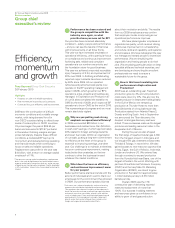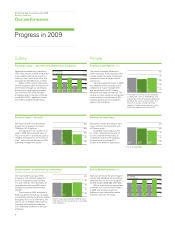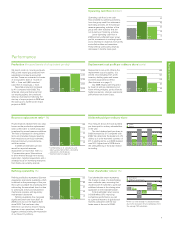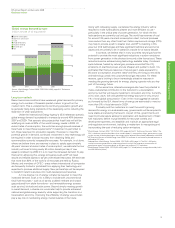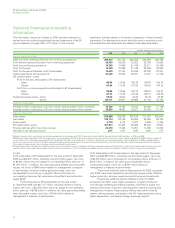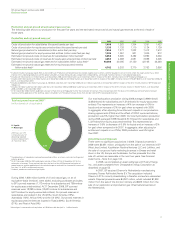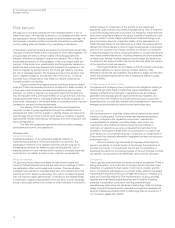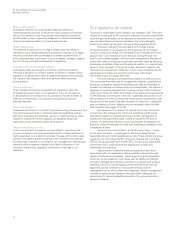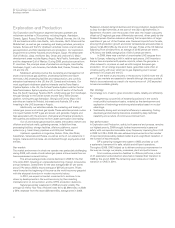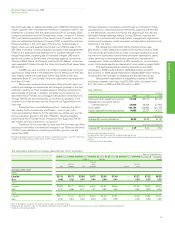BP 2009 Annual Report Download - page 15
Download and view the complete annual report
Please find page 15 of the 2009 BP annual report below. You can navigate through the pages in the report by either clicking on the pages listed below, or by using the keyword search tool below to find specific information within the annual report.
13
BP Annual Report and Accounts 2009
Business review
Business review
Business review – Group overview
Global energy demand by type
(million tonnes of oil equivalent)
Other renewables 20
Biomass and waste
Coal
Hydroelectricity
Nuclear energy 16
Natural gas
Oil
12
8
4
1990 2007 2015 2030
Source: World Energy Outlook 2009. ©
OECD/IEA 2009, page 622: ‘Reference
Scenario, World’.
Long-term outlook
Recent economic conditions have weakened global demand for primary
energy, but a number of forecasts predict a return to growth in the
medium term. This is underpinned by continuing population growth and
by generally rising living standards in the developing world, including the
expansion of urban populations.
Under the International Energy Agency’s (IEA) reference scenario,
global energy demand is projected to increase by around 40% between
2007 and 2030a. That scenario also projects that fossil fuels will still be
satisfying as much as 80% of the world’s energy needs in 2030. At
current rates of consumption, the world has enough proved reserves of
fossil fuels to meet these requirementsbif investment is permitted to
turn those reserves into production capacity. However, to meet the
potential growth in demand, continued investment in new technology will
be required in order to boost recovery from declining fields and
commercialize currently inaccessible resources. For example, in oil alone,
where we believe there are reserves in place to satisfy approximately
40 years’ demand at current rates of consumptionb, we estimate that our
industry will need to bring nearly 50 million barrels per day of new
capacity onstream by 2030 if it is to meet the increased demand. To play
their part in achieving this, energy companies such as BP will need
secure and reliable access to as-yet undeveloped resources. We estimate
that more than 80% of the world’s oil resources are held by Russia,
Mexico and members of OPEC – areas where international oil companies
are frequently limited or prohibited from applying their technology and
expertise to produce additional supply. New partnerships will be required
to transform latent resources into much-needed proved reserves.
A more diverse mix of energy will also be required to meet this
increased demand. Such a mix is likely to include both unconventional
fossil fuel resources – such as oil sands, coalbed methane and natural
gas produced from shale formations – and renewable energy sources
such as wind, biofuels and solar power. Beyond simply meeting growth
in overall demand, a diverse mix would also help to provide enhanced
national and global energy security while supporting the transition to a
lower-carbon economy. Improving the efficiency of energy use will also
play a key role in maintaining energy market balance in the future.
Along with increasing supply, we believe the energy industry will be
required to make hydrocarbons cleaner and more efficient to use –
particularly in the critical area of power generation, for which the key
hydrocarbons are currently coal and gas. The world has reserves of coal
for around 120 years at current consumption ratesb, but coal produces
more carbon than any other fossil fuel. Carbon capture and storage (CCS)
may help to provide a path to cleaner coal, and BP is investing in this
area, but CCS technologies still face significant technical and economic
issues and are unlikely to be in operation at scale for at least a decade.
In contrast, we believe that in many countries natural gas has the
potential to provide the most significant reductions in carbon emissions
from power generation in the shortest time and at the lowest cost. These
reductions can be achieved using technology available today. Combined-
cycle turbines, fuelled by natural gas, produce around half the CO2
emissions of coal-fired power, and are cheaper and quicker to build. It is
estimated that there are reserves of natural gas in place equivalent to
60 years’ consumption at current ratesband they are rising as new skills
and technology unlock new unconventional gas resources. For these
reasons, gas is looking to be an increasingly attractive resource in
meeting the growing demand for energy, playing a greater role as a key
part of the energy future.
At the same time, alternative energies also have the potential to
make a substantial contribution to the transition to a lower-carbon
economy, but this will require investment, innovation and time. Currently,
wind, solar, wave, tide and geothermal energy account for only around
1% of total global consumptionc. Even in the most aggressive scenario
put forward by the IEA, these forms of energy are estimated to meet no
more than 5% of total demand in 2030d.
If industry and the market are to meet the world’s growing
demand for energy in a sustainable way, governments will be required to
set a stable and enduring framework. As part of this, governments will
need to provide secure access for exploration and development of fossil
fuel resources, define mutual benefits for resource owners and
development partners, and establish and maintain an appropriate legal
and regulatory environment, including a mechanism for recognizing and
incorporating the cost of reducing carbon emissions.
aWorld Energy Outlook 2009. ©OECD/IEA 2009, pages 622-623: ‘Reference Scenario, World’. The
IEA’s reference scenario describes what would happen if, among other things, governments were
to take no new initiatives bearing on the energy sector, beyond those already adopted by mid-2009.
bBP Statistical Review of World Energy June 2009. This estimate is not based on proved reserves as
defined by SEC rules.
cAdapted from World Energy Outlook 2009. ©OECD/IEA 2009, page 74. The IEA’s 450 policy
scenario assumes governments adopt commitments to limit the long-term concentration of
greenhouse gases in the atmosphere to 450 parts per million of CO2equivalent.
dWorld Energy Outlook 2009. ©OECD/IEA 2009, page 212: ‘World primary energy demand by fuel in
the 450 Scenario (Mtoe)’.





